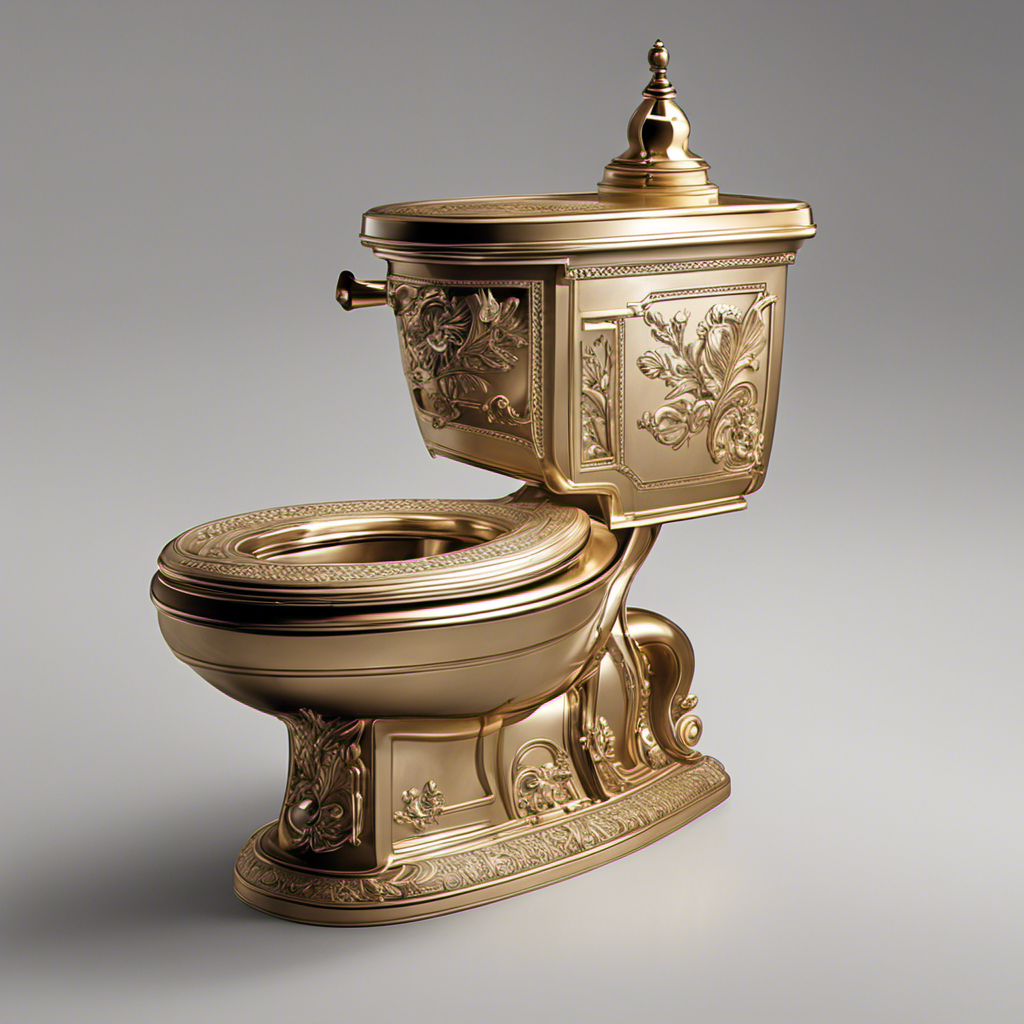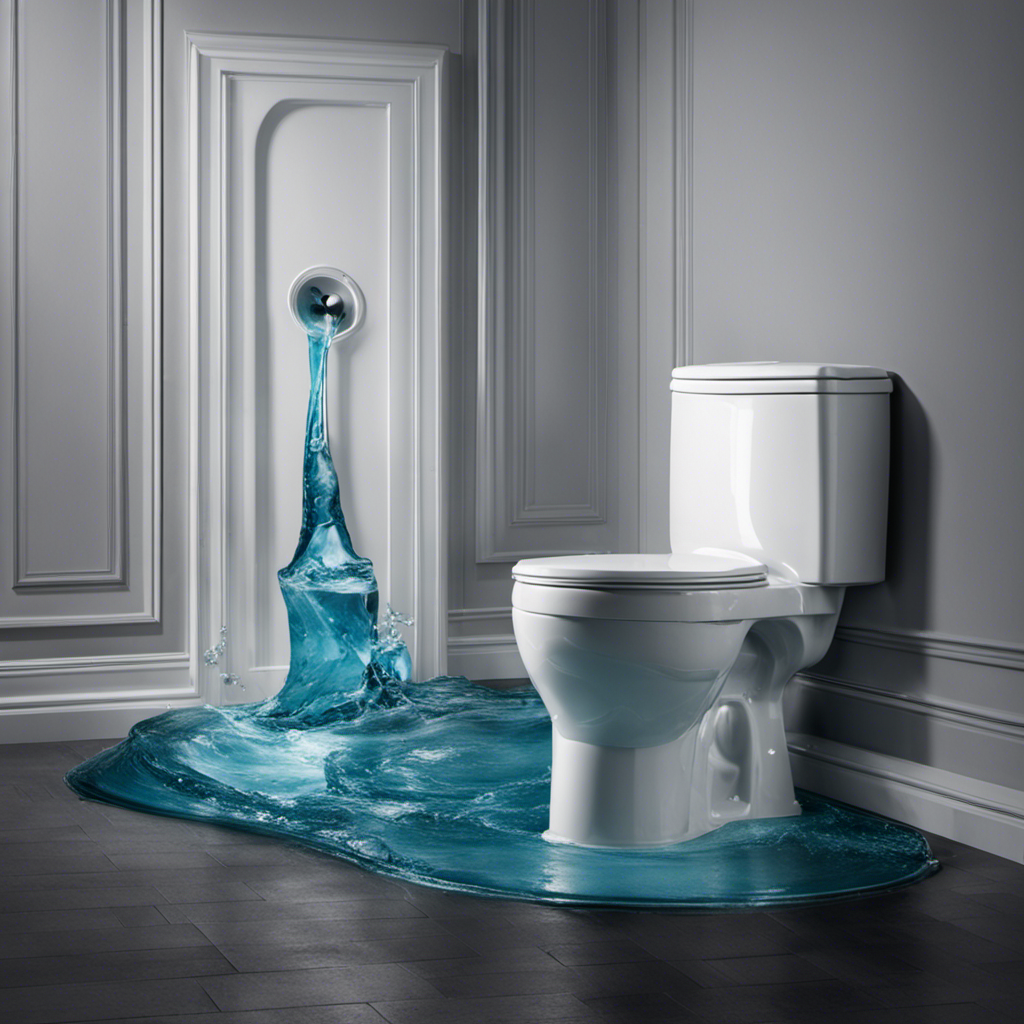Ever been curious about the significance of GPF labeled on your toilet tank? We’re here to deliver the explanations you’re looking for.
In this article, we will explore the importance of understanding GPF, its definition, how it is measured, and the historical background behind it.
We will also discuss the environmental impact of GPF and provide tips on how to calculate and reduce GPF usage.
So, let’s dive in and become masters of toilet knowledge!
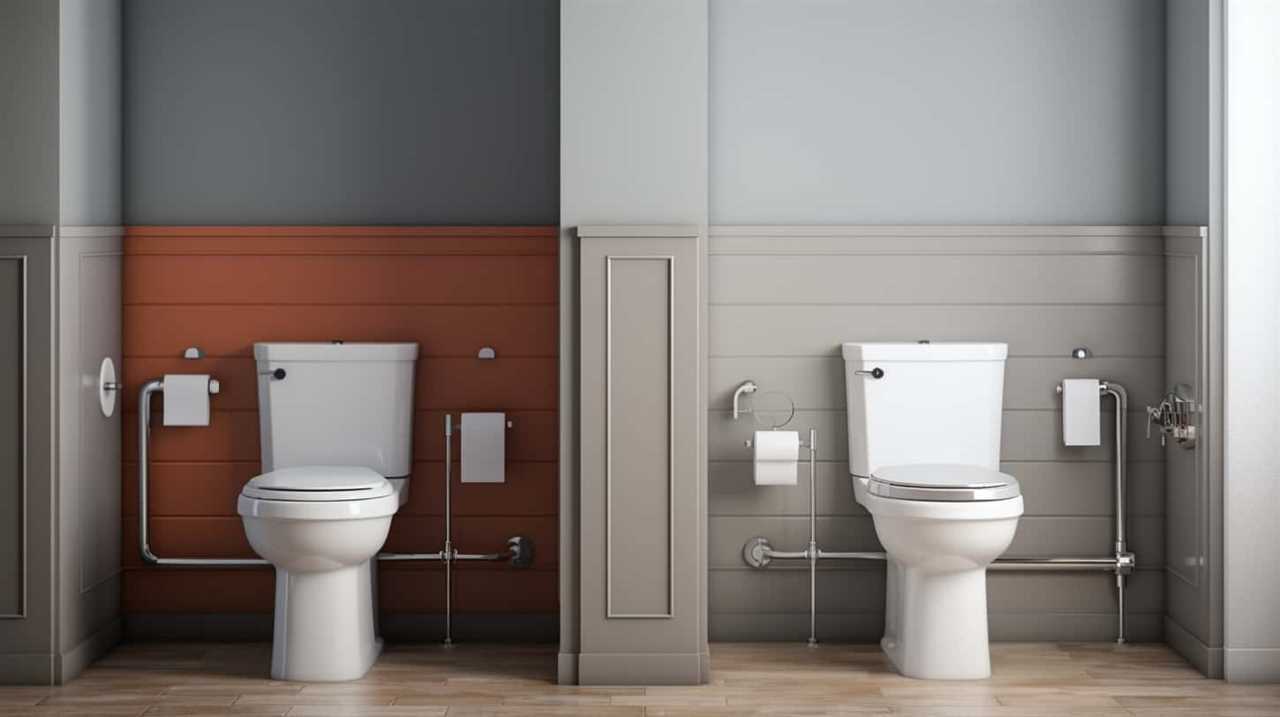
Key Takeaways
- GPF stands for gallons per flush and is a measurement used to determine the amount of water a toilet uses to flush.
- Lowering GPF helps in maximizing water efficiency and can save money on water bills.
- Traditional toilets have higher GPF values, while newer models have lower GPF values, reducing water consumption without compromising performance.
- GPF standards and regulations aim to reduce water wastage, promote sustainability, and address water scarcity.
Importance of Understanding GPF
Understanding the importance of knowing the GPF (gallons per flush) of a toilet is crucial for us as homeowners. Water saving initiatives have become increasingly important in recent years, and knowing the GPF of our toilets allows us to contribute to these efforts.
By choosing a toilet with a lower GPF, we can significantly reduce our water consumption and contribute to the conservation of this valuable resource.
Additionally, understanding the impact of GPF on our plumbing systems is essential. Higher GPF toilets often put more strain on our pipes and sewage systems, leading to potential clogs and increased maintenance costs.
Definition of GPF
GPF, or gallons per flush, is a measurement used to determine the amount of water a toilet uses to flush. Understanding GPF is important because it directly affects water efficiency and can impact water bills.
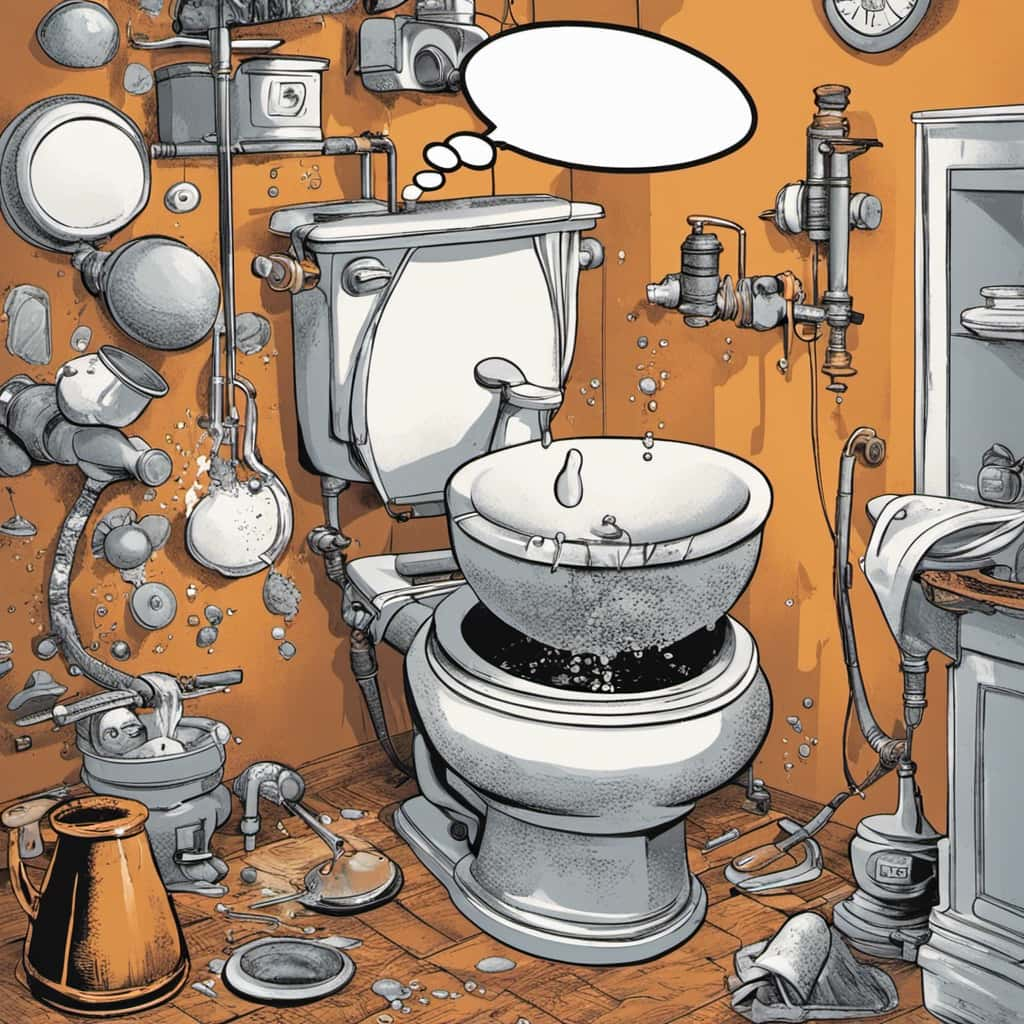
GPF and Water Efficiency
To maximize water efficiency, we can reduce the gallons per flush (GPF) of a toilet by using a lower volume of water for each flush. Water-saving measures, such as reducing the GPF, play a crucial role in conserving water and promoting sustainability.
GPF refers to the amount of water used per flush in a toilet. Traditional toilets typically have a GPF of around 3.5 or more, while newer models are designed to have lower GPF values, such as 1.6 or even 1.28. By using less water per flush, these toilets help reduce water consumption without compromising performance.
Plumbing systems are an integral part of ensuring water efficiency, and by using toilets with lower GPF, we can contribute to a more sustainable future.
Impact on Water Bills
Continuing the discussion from the previous subtopic, using a lower GPF in toilets can have a significant impact on our water bills. Implementing water saving strategies not only helps conserve water but also reduces the financial burden on our household budget.
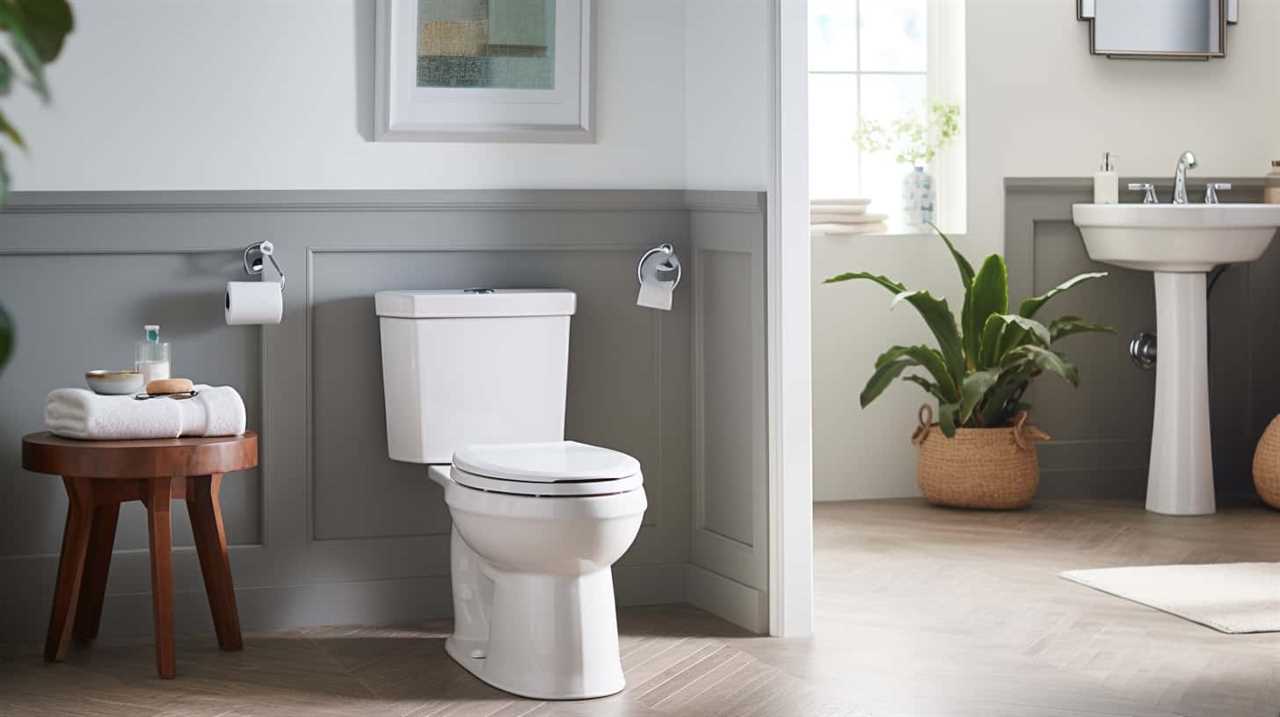
Here are some key ways in which a lower GPF can save us money:
- Reducing water consumption by opting for toilets with lower GPF.
- Lowering the amount of water wasted with each flush.
- Decreasing water usage without compromising on flushing efficiency.
- Minimizing the strain on our water resources while maintaining a cost-effective approach.
Choosing the Right GPF
Now let’s explore how to select the right GPF for our specific needs, considering the definition of GPF and its impact on water consumption and cost savings.
GPF stands for Gallons Per Flush and refers to the amount of water flushed down the toilet with each use. Choosing the right GPF is crucial as it directly affects water consumption and cost savings.
When comparing GPF options, it’s important to consider the toilet design as well. Older toilets typically have higher GPF ratings, ranging from 3.5 to 7 GPF, whereas newer, more efficient toilets have lower GPF ratings, typically ranging from 1.28 to 1.6 GPF.
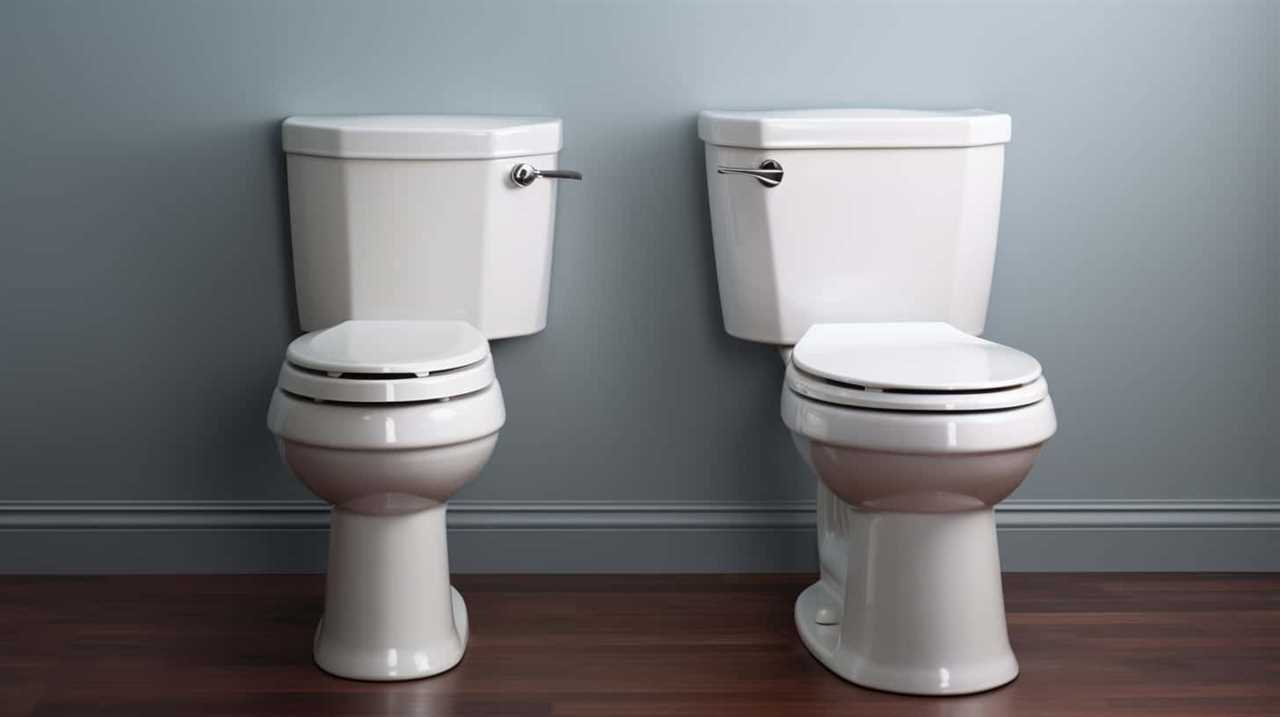
How GPF Is Measured
When it comes to determining the amount of water used by a toilet, the measurement of gallons per flush (GPF) is determined through the use of a water meter. To ensure measuring accuracy, manufacturers use a GPF conversion formula that takes into account the volume of water released during a flush.
Here is a breakdown of how GPF is measured:
- Water meter: A device installed in the toilet’s water supply line that measures the amount of water flowing into the tank.
- Flush test: A controlled experiment where the toilet is flushed multiple times, and the water meter records the volume of water used.
- Calculation: Using the GPF conversion formula, the volume of water measured by the water meter is converted into gallons per flush.
- Certification: Toilet manufacturers submit their models for testing to independent organizations, such as the Environmental Protection Agency, to ensure compliance with GPF regulations.
Understanding how GPF is measured allows consumers to make informed decisions when choosing a toilet that meets their water conservation needs.
Historical Background of GPF
To understand the historical background of GPF, we can trace its origins back to the early development of modern plumbing systems. GPF, or gallons per flush, refers to the amount of water used by a toilet when it’s flushed.
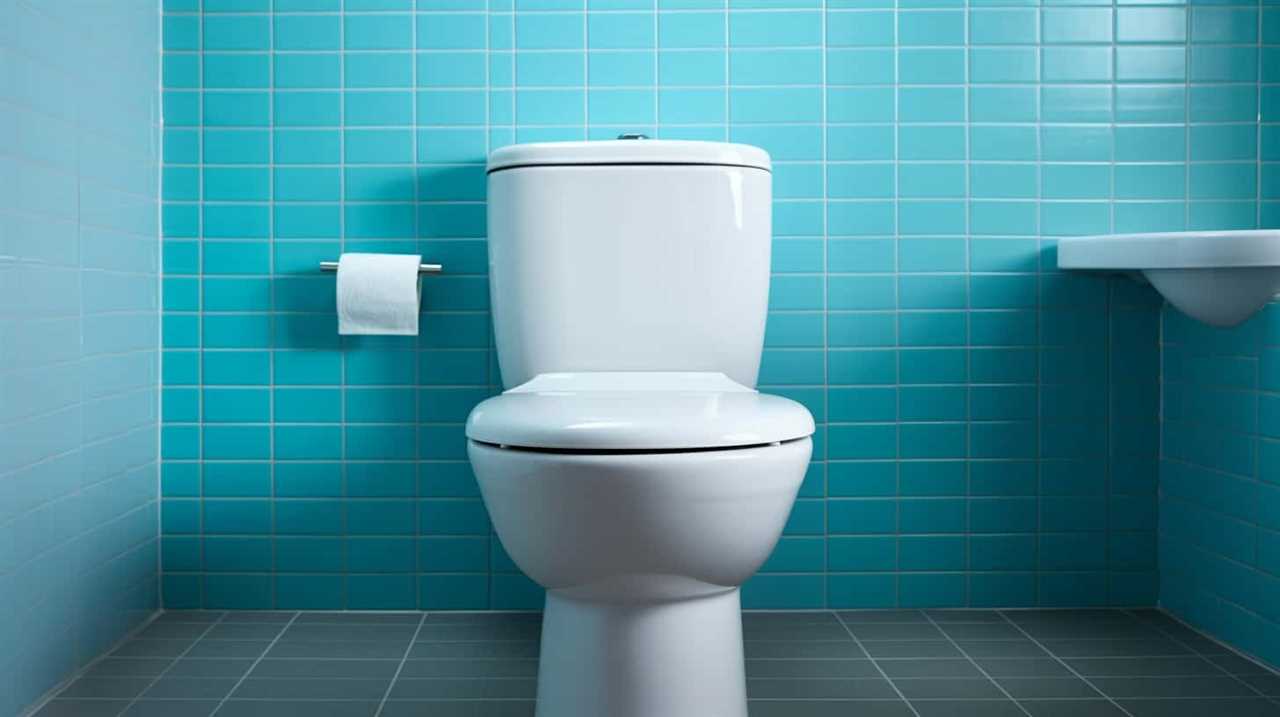
Over time, there’s been an evolution in GPF, driven by the need for water conservation and efficiency. In the past, toilets used a much higher GPF, typically around 3.5 to 7 gallons per flush.
However, with advancements in technology and a growing focus on sustainability, modern toilets now have a much lower GPF, typically ranging from 1.28 to 1.6 gallons per flush. This reduction in GPF has significantly contributed to water conservation efforts and has become the standard in many countries.
Understanding the historical evolution of GPF is crucial in appreciating the current standards and regulations in place to ensure water efficiency and sustainability.
GPF Standards and Regulations
GPF standards and regulations play a crucial role in water conservation efforts. By limiting the amount of water used per flush, these regulations aim to reduce water wastage and promote sustainability.

The impact of GPF regulations can be seen in the significant decrease in water consumption over the years, making toilets more efficient and environmentally friendly.
GPF and Water Conservation
In our efforts to promote water conservation, we adhere to the GPF standards and regulations established for toilet tanks. These regulations play a crucial role in reducing water consumption and addressing water scarcity.
Here are some key points to understand about GPF and water conservation:
- GPF and toilet design: The GPF rating on a toilet tank indicates the number of gallons of water used per flush. Modern toilets are designed to be more efficient, using less water without compromising on performance.
- GPF and water scarcity: With increasing concerns about water scarcity, it’s essential to minimize water wastage. By adhering to GPF standards, we can significantly reduce water usage in households and conserve this precious resource.
- GPF regulations and environmental impact: The implementation of GPF regulations has led to significant water savings on a large scale. These regulations have helped reduce the strain on water resources and contribute to a more sustainable future.
Impact of GPF Regulations
By consistently adhering to GPF (gallons per flush) standards and regulations, we can actively contribute to the positive impact of water conservation efforts. These regulations aim to reduce the amount of water used in each flush, resulting in significant water savings over time. However, it is important to understand that there can be an impact on toilet performance with lower GPF requirements. To illustrate this, let’s take a look at the table below:
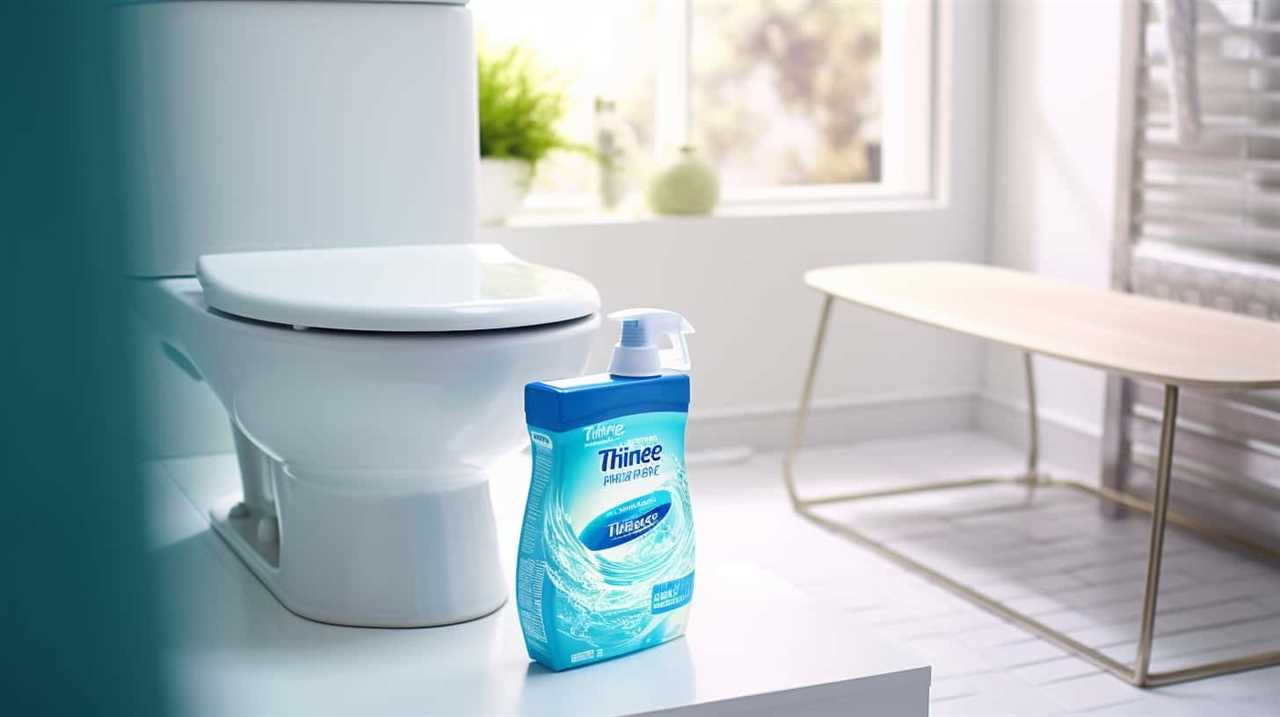
| GPF Requirement | Water Savings (per year) | Toilet Performance |
|---|---|---|
| 1.6 | 7,300 gallons | High efficiency |
| 1.28 | 9,125 gallons | Good efficiency |
| 1.0 | 11,500 gallons | Moderate efficiency |
As the GPF requirement decreases, there is a corresponding increase in water savings. However, it is essential to choose a toilet that balances water conservation with efficient performance. Manufacturers have developed innovative technologies and designs to ensure that toilets with lower GPF requirements still provide effective flushing power. By selecting a toilet that meets both GPF regulations and performance needs, we can make a significant impact on water conservation while maintaining a high level of functionality.
Different GPF Options Available
We can explore the various options available for toilet tanks in terms of gallons per flush (GPF).
When it comes to toilet efficiency, it’s important to consider the GPF options that are available. Here are some options to consider:
- 1.6 GPF: This is the standard option that has been in use for many years. It provides a decent flush while still conserving water.
- 1.28 GPF: This option is more water-efficient than the standard 1.6 GPF. It still provides a powerful flush while using less water.
- 0.8 GPF: This is an ultra-low GPF option that’s designed for maximum water conservation. It’s ideal for areas with strict water regulations.
- Dual-flush toilets: These toilets offer the option of using different GPF levels for liquid waste and solid waste, further optimizing water usage.
Now that we understand the different GPF options available, let’s explore the pros and cons of low GPF toilets.
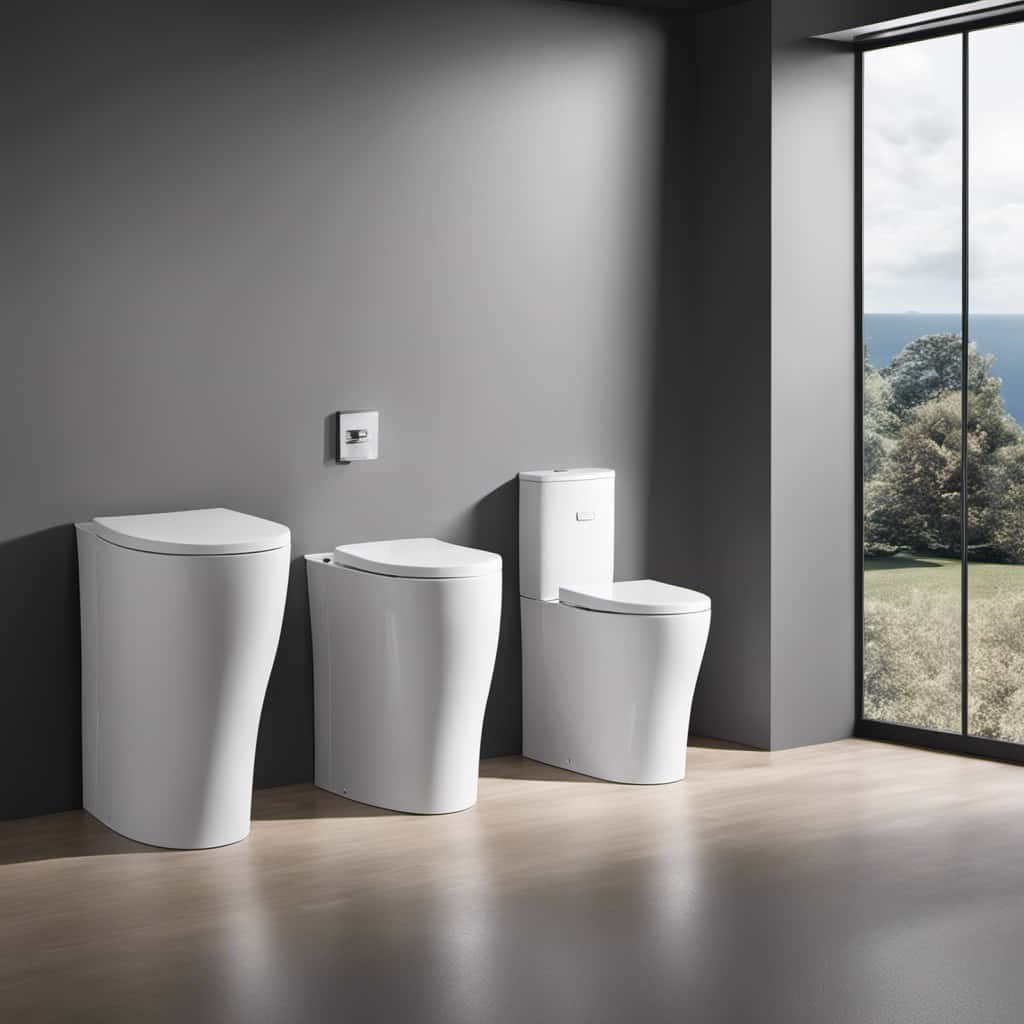
Pros and Cons of Low GPF Toilets
Low GPF toilets offer significant water conservation benefits, helping to reduce our environmental impact by using less water per flush.
However, it’s important to consider the flushing power of these toilets, as they may not be as effective in removing waste compared to higher GPF options.
Additionally, low GPF toilets can provide long-term cost-saving potential by reducing water bills, but the upfront cost of purchasing and installing these toilets should also be taken into account.
Water Conservation Benefits
With the aim of reducing water consumption, the benefits and drawbacks of toilets with a low GPF are worth considering. Low flow toilets, also known as water-saving toilets, offer several advantages when it comes to water conservation. Here are some key benefits to keep in mind:

- Efficient flushing: Low flow toilets use less water per flush, typically around 1.28 gallons per flush (GPF) compared to the standard 1.6 GPF. This results in significant water savings over time.
- Cost savings: By reducing water usage, low flow toilets can lead to lower water bills, providing financial benefits for homeowners and businesses alike.
- Environmental impact: With less water being used for flushing, low flow toilets help conserve water resources and reduce strain on water treatment facilities.
- Compliance with regulations: Many regions have implemented water conservation regulations that require the use of low flow toilets, making them a necessary choice for compliance.
While low flow toilets offer numerous benefits, it’s important to consider potential drawbacks such as reduced flushing power and the need for occasional double flushing. However, with advancements in technology, these drawbacks are becoming less of an issue, making low flow toilets an effective solution for water conservation.
Flushing Power Comparison
One important aspect to consider when comparing flushing power is the impact of different GPF levels on toilet performance. Flushing power refers to the ability of a toilet to effectively remove waste with a single flush.
Low GPF toilets, typically ranging from 1.28 to 1.6 gallons per flush, are designed to conserve water while still providing sufficient flushing power. These toilets use innovative technologies such as pressure-assisted flushing or larger trapways to maximize the efficiency of each flush.
However, it’s important to note that some low GPF toilets may not perform as well as higher GPF toilets when it comes to flushing bulk waste.
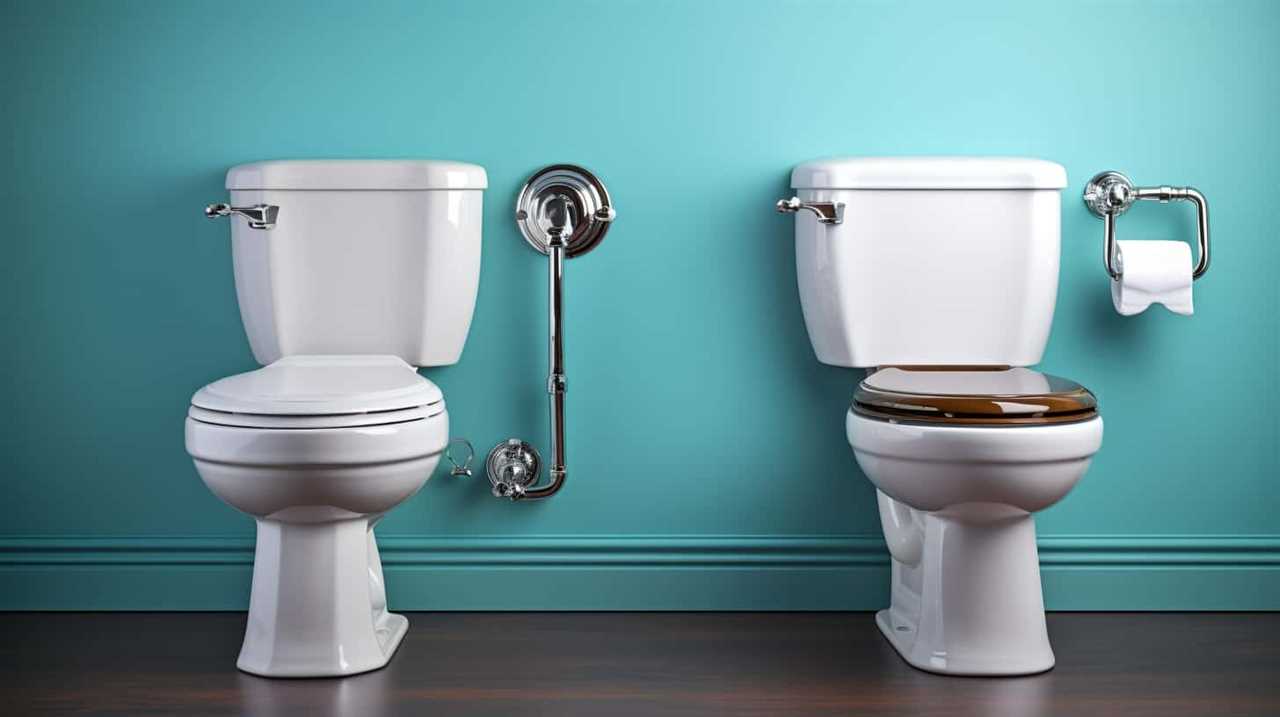
This trade-off between water usage and flushing power should be considered when choosing a toilet, as it ultimately depends on personal preference and specific needs.
Cost-Saving Potential Analysis
Our analysis of the cost-saving potential of low GPF toilets reveals the benefits and drawbacks of these water-conserving fixtures. When considering the GPF cost analysis and GPF savings potential, here is what you need to know:
- Reduced water consumption: Low GPF toilets use significantly less water per flush, which can lead to substantial water savings over time.
- Lower water bills: With less water being used, homeowners can expect to see a decrease in their monthly water bills.
- Environmental impact: By conserving water, low GPF toilets contribute to a more sustainable and eco-friendly lifestyle.
- Potential drawbacks: While low GPF toilets offer cost-saving benefits, they may have lower flushing power compared to higher GPF toilets, which could result in the need for multiple flushes.
Considering these factors, it’s important to weigh the pros and cons of low GPF toilets against the benefits and drawbacks of high GPF toilets.
Pros and Cons of High GPF Toilets
Although high GPF toilets have some advantages, there are also drawbacks to consider.
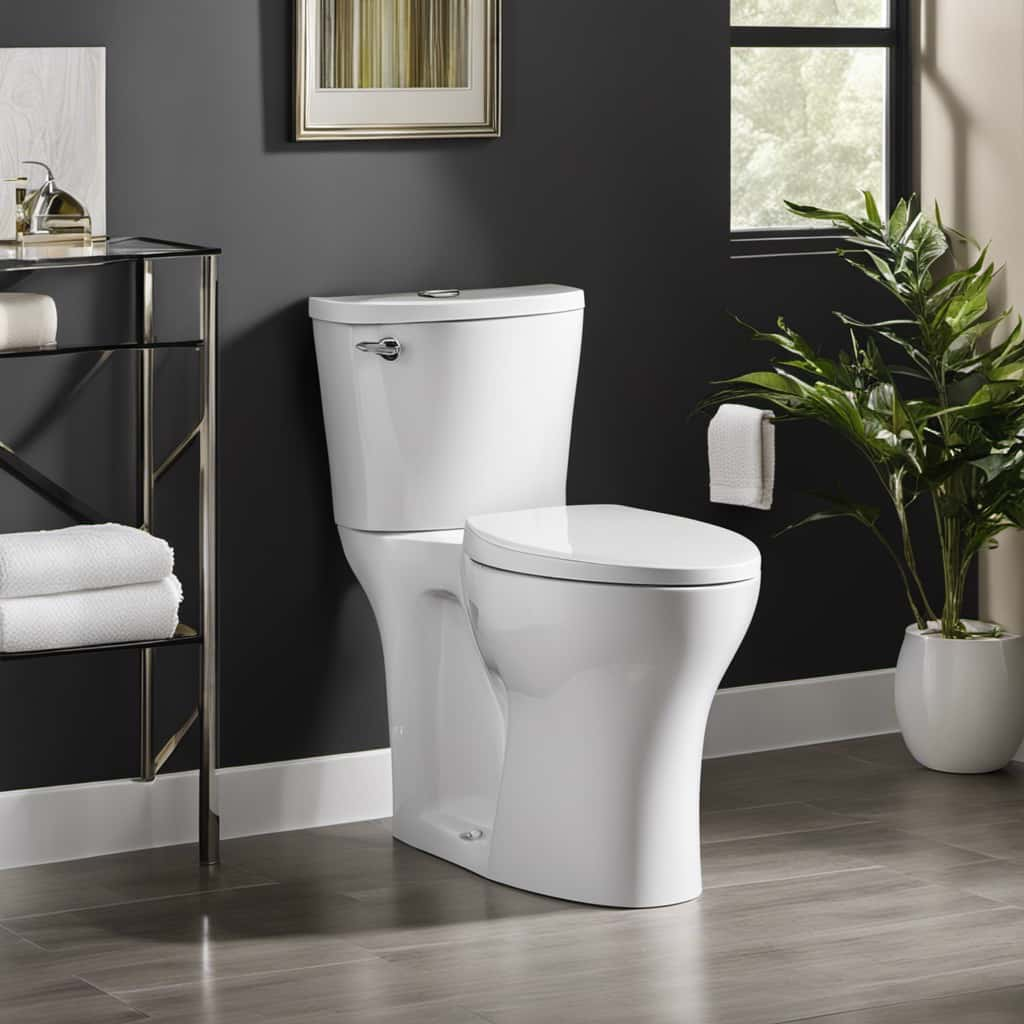
One of the main benefits of high GPF toilets is that they provide a powerful flush, which can be helpful in removing waste effectively. Additionally, high GPF toilets may be more affordable compared to low GPF toilets, making them a cost-effective option for some consumers.
However, there are also downsides to using high GPF toilets. Firstly, they consume more water per flush, which can lead to higher water bills and have a negative environmental impact. Furthermore, high GPF toilets may contribute to water scarcity in areas where water resources are limited.
Therefore, when choosing a GPF for your toilet, it’s important to consider factors such as water saving options and the environmental impact of your choice.
Factors to Consider When Choosing GPF
When selecting the GPF for your toilet, it’s essential to consider various factors. Here are some factors to consider when choosing the GPF for your toilet:
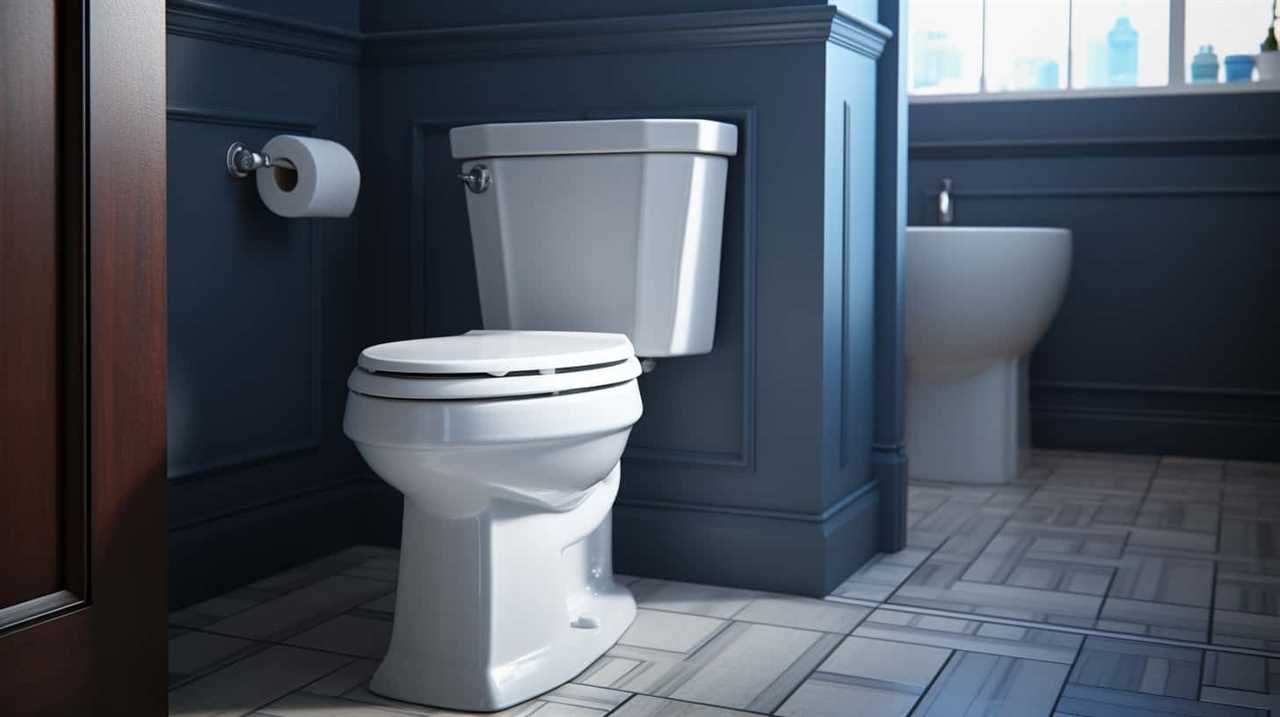
- Water efficiency: Look for toilets that have a low GPF rating, such as 1.28 or 1.6 GPF. These toilets are designed to conserve water and reduce water bills.
- Flush performance: Consider toilets that have a powerful flush despite their low GPF rating. Look for toilets with features like larger trapways and optimized bowl designs for efficient waste removal.
- Budget: Determine your budget and find a toilet that meets your water-saving needs without breaking the bank. Remember that water-saving options can vary in price, so choose one that fits your budget.
- Durability: Look for toilets with reliable construction and quality materials to ensure long-lasting performance and avoid costly repairs in the future.
How GPF Affects Water Consumption
Now let’s delve into how GPF directly impacts the amount of water consumed by a toilet.
GPF, or gallons per flush, is a crucial factor in determining water usage. By choosing a toilet with a lower GPF, you can significantly reduce your household’s water consumption. This not only helps you save money on your water bill but also contributes to water conservation efforts.
A toilet with a lower GPF uses less water for each flush, resulting in reduced household water usage patterns. Additionally, lower GPF toilets contribute to plumbing system maintenance by placing less strain on the pipes and reducing the risk of clogs.
Understanding the relationship between GPF and water consumption is essential for making informed choices about toilet fixtures.
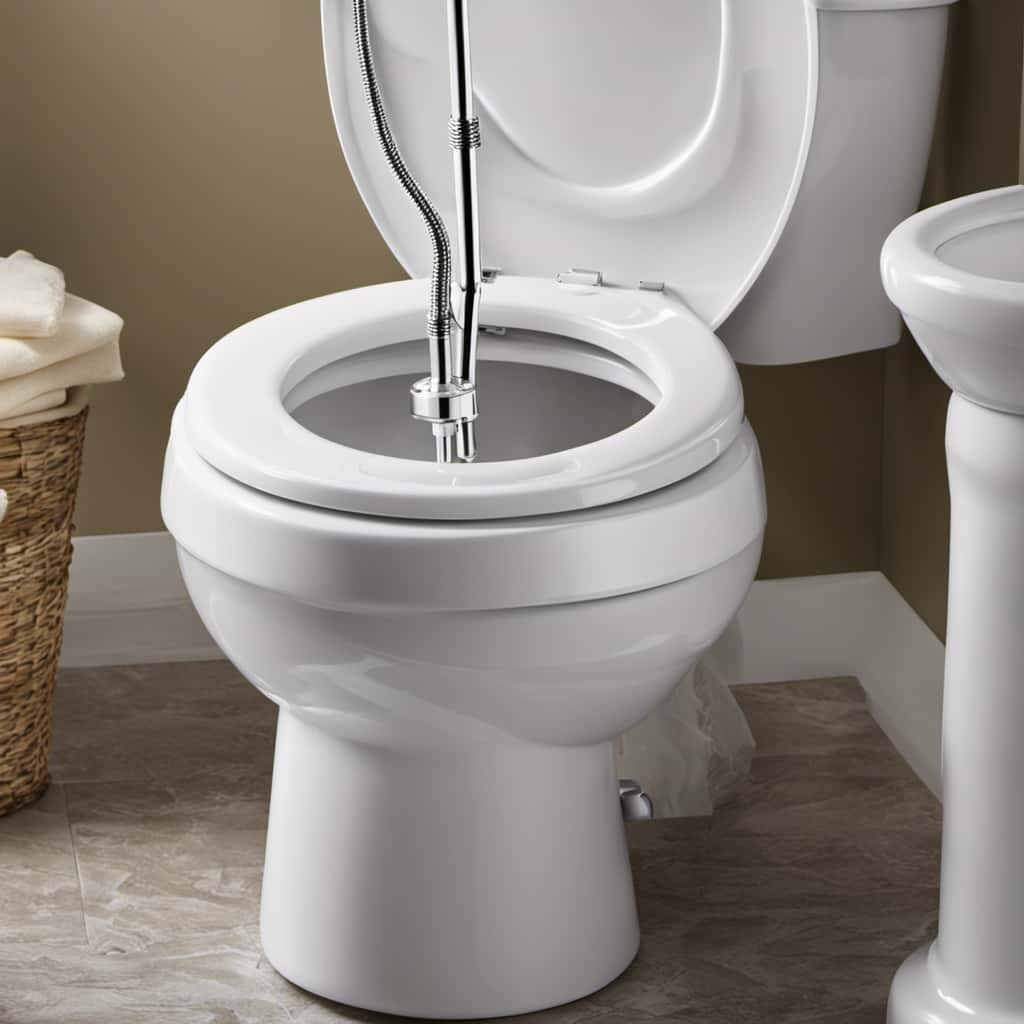
Now, let’s explore the environmental impact of GPF.
Environmental Impact of GPF
When considering the environmental impact of GPF, there are three key points to discuss.
Firstly, water conservation strategies are crucial in reducing the amount of water wasted during each flush.
Secondly, the impact on sewer systems should be taken into account, as high GPF toilets can contribute to overloaded systems and increased maintenance costs.
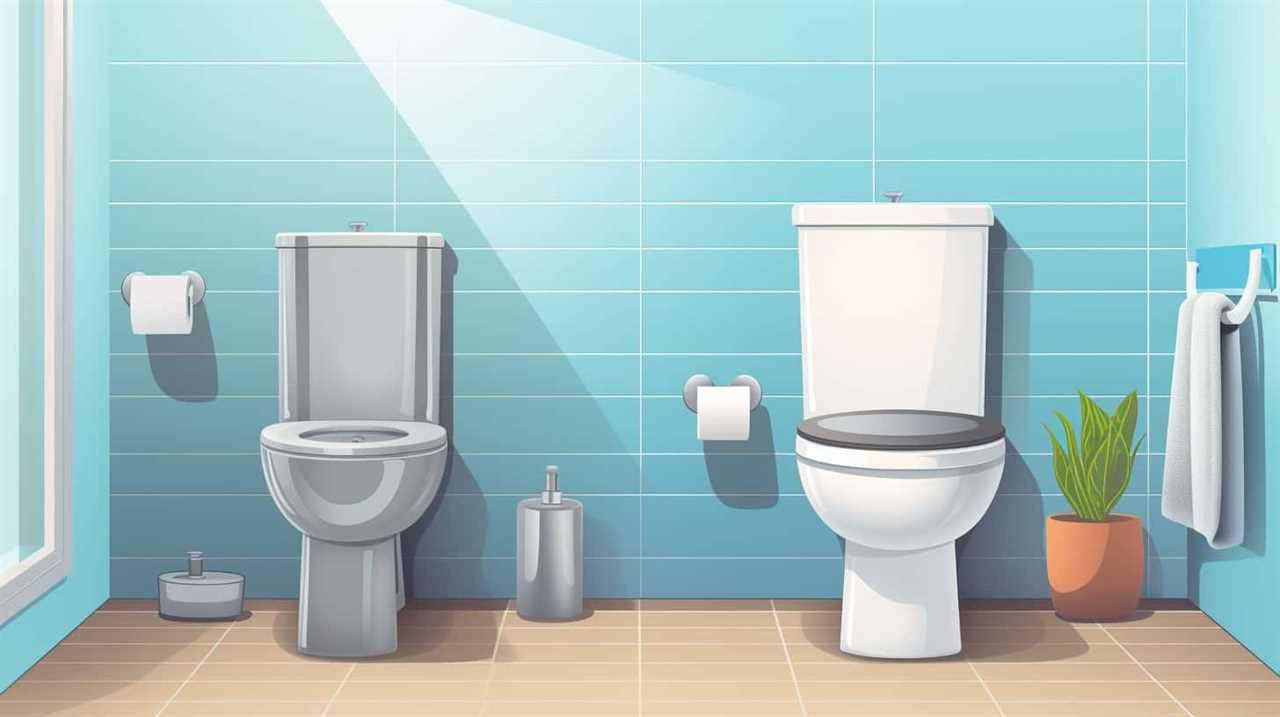
Lastly, advancements in toilet flushing technology, such as dual-flush systems, offer a more sustainable option by allowing users to choose between a lower or higher flush depending on their needs.
Water Conservation Strategies
Our household’s water conservation strategies include reducing the environmental impact of GPF. To achieve this, we’ve implemented the following water-saving techniques and toilet design choices:
- Installing low-flow toilets: These toilets are designed to use less water per flush compared to traditional models.
- Dual-flush toilets: These toilets have two buttons, allowing us to choose between a lower GPF for liquid waste and a higher GPF for solid waste.
- Water displacement devices: Placing a filled water bottle or a brick in the toilet tank helps reduce the amount of water used during each flush.
- Regular maintenance: Ensuring that our toilets are in good working condition, with no leaks or running water, helps conserve water.
By employing these strategies, we’re actively reducing our water consumption and minimizing the environmental impact of GPF.
However, it’s important to consider the impact these water-saving measures may have on sewer systems.
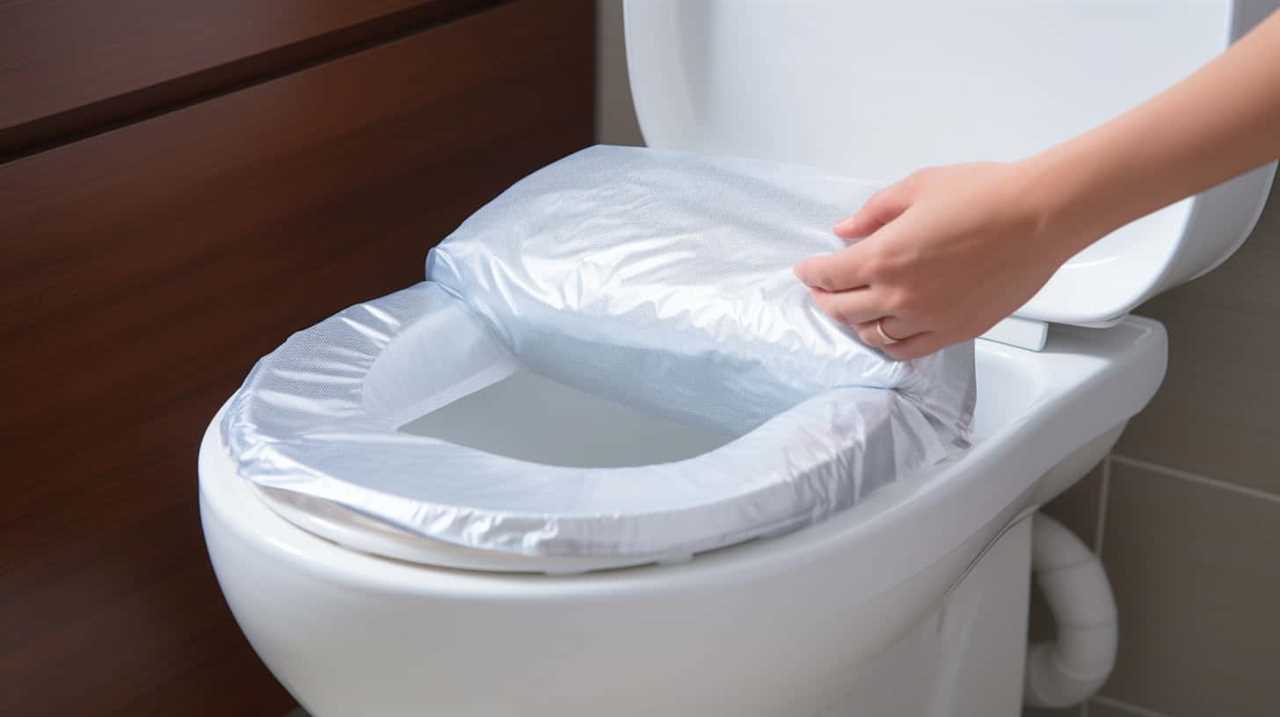
Impact on Sewer Systems
To understand the impact of GPF on sewer systems, we must consider its environmental implications.
GPF, or gallons per flush, directly affects sewer system capacity and water pollution. When toilets use a higher GPF, more water is flushed into the sewer system. This increased volume of water can exceed the capacity of the system, leading to backups and overflows.
Additionally, the excess water can dilute the sewage, reducing its effectiveness in wastewater treatment plants. This can result in higher levels of pollutants, such as nitrogen and phosphorus, entering our waterways and contributing to water pollution.
Toilet Flushing Technology
Toilet flushing technology has evolved to include water-saving innovations that aim to reduce water consumption. There are several ways in which toilet flushing technology can have an environmental impact.
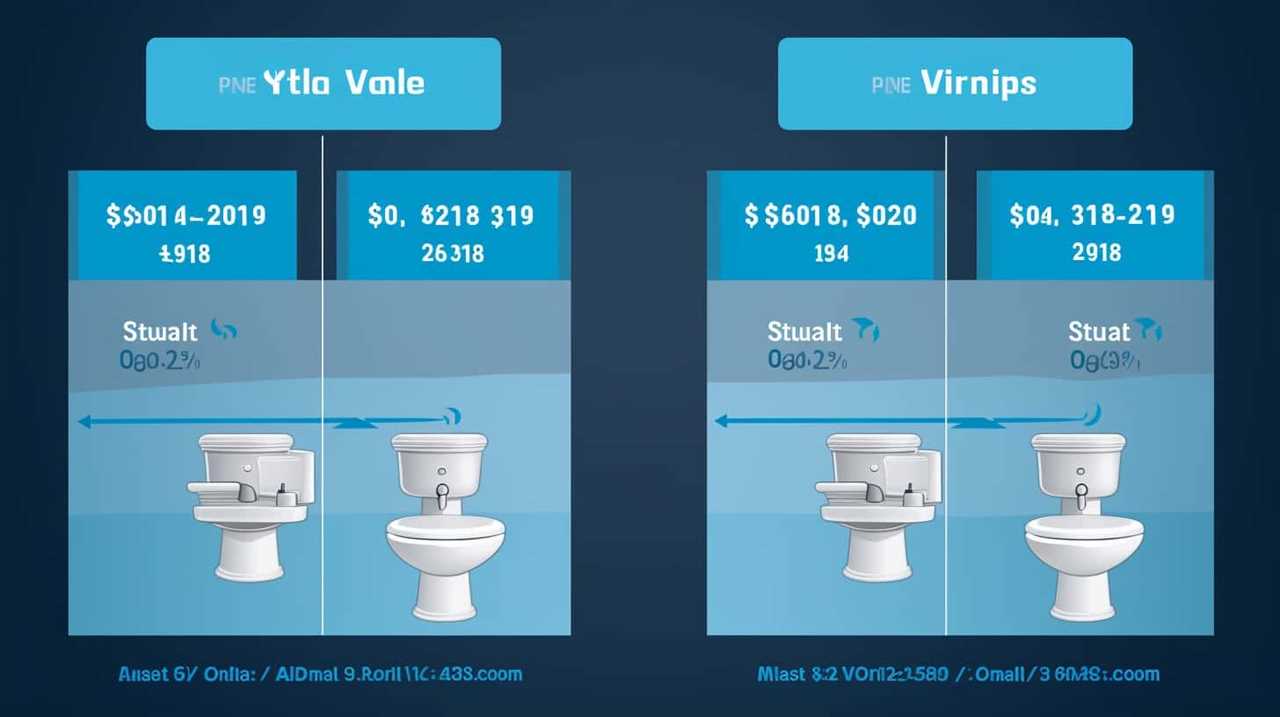
- Dual-flush toilets are designed with two flushing options, allowing users to choose between a full flush for solid waste and a partial flush for liquid waste. This effectively reduces the amount of water used.
- Pressure-assisted toilets use compressed air or water to create a powerful flush, requiring less water compared to traditional gravity-fed toilets.
- Low-flow toilets are designed with smaller tanks and redesigned bowls to optimize water usage. They typically use 1.6 gallons per flush (GPF) or less.
- High-efficiency toilets take water-saving a step further by using advanced flushing mechanisms and designs. These toilets achieve even lower GPF, often around 1.28 or even 0.8 GPF.
Implementing these water-saving technologies can minimize water waste and contribute to a more sustainable future.
Now, let’s delve into how to calculate GPF usage.
How to Calculate GPF Usage
To calculate GPF usage, we can measure the volume of water in the toilet tank before and after flushing. This method allows us to determine how much water is used per flush, providing valuable information for calculating water usage and measuring water efficiency.
To begin, we need a measuring container that can hold the entire volume of water in the tank. Before flushing, carefully place the container in the tank and note the water level. After flushing, collect the water in the container and measure its volume.
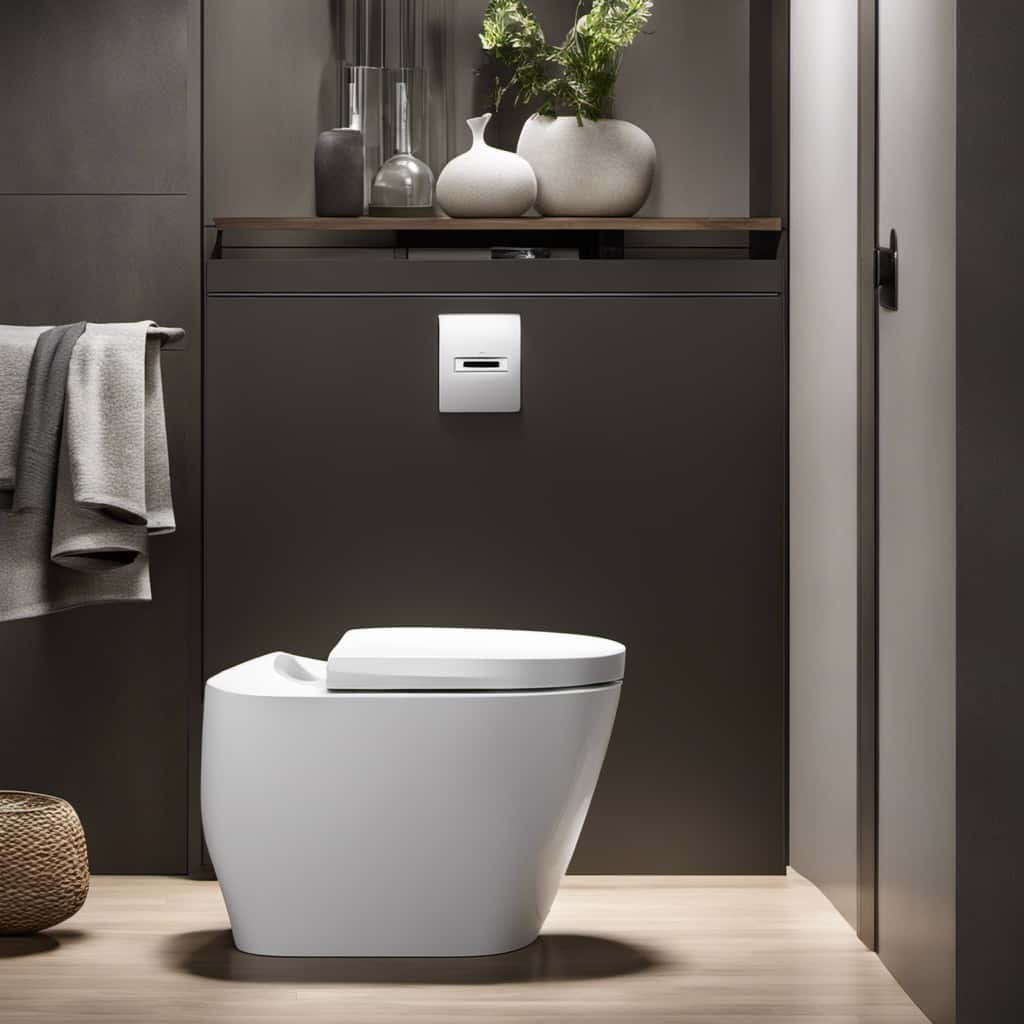
The difference between the initial and final volumes represents the amount of water used per flush, which can be converted to gallons per flush (GPF) by dividing by 128.
By accurately calculating GPF usage, we can make informed decisions about water conservation and explore ways to reduce water consumption in our toilets.
Now, let’s move on to the next section where we’ll discuss some tips for reducing GPF.
Tips for Reducing GPF
Let’s explore some ways we can cut down on GPF usage in our toilets. Here are some tips for reducing water usage and making our toilets more eco-friendly:

- Install a dual-flush toilet: These toilets have two options for flushing, allowing you to choose between a full flush for solid waste and a half flush for liquid waste. This can significantly reduce the amount of water used per flush.
- Adjust the fill valve: By adjusting the fill valve, you can ensure that the tank fills up with the right amount of water, preventing unnecessary water waste.
- Consider using a toilet tank displacement device: Placing a device such as a water-filled plastic bottle or a brick in the toilet tank can reduce the amount of water used per flush.
- Fix leaks promptly: Leaks in toilets can waste a significant amount of water. Regularly check for leaks and repair them promptly to minimize water usage.
Implementing these tips can help us reduce water usage and choose more eco-friendly toilets.
Conclusion: Making Informed Toilet Choices
When considering our options for more eco-friendly toilets, it’s important for us to make informed choices. By conducting a toilet efficiency analysis, we can evaluate the water-saving technologies available and select a toilet that meets our needs while minimizing water consumption.
Several factors should be considered during this analysis, such as the toilet’s flush volume, which is measured in gallons per flush (GPF). Opting for a toilet with a lower GPF can significantly reduce water usage. Additionally, features like dual-flush mechanisms and pressure-assisted flushing systems can further enhance water efficiency.
Understanding these technologies and their impact on water conservation allows us to choose a toilet that not only meets our personal preferences but also contributes to a more sustainable future.
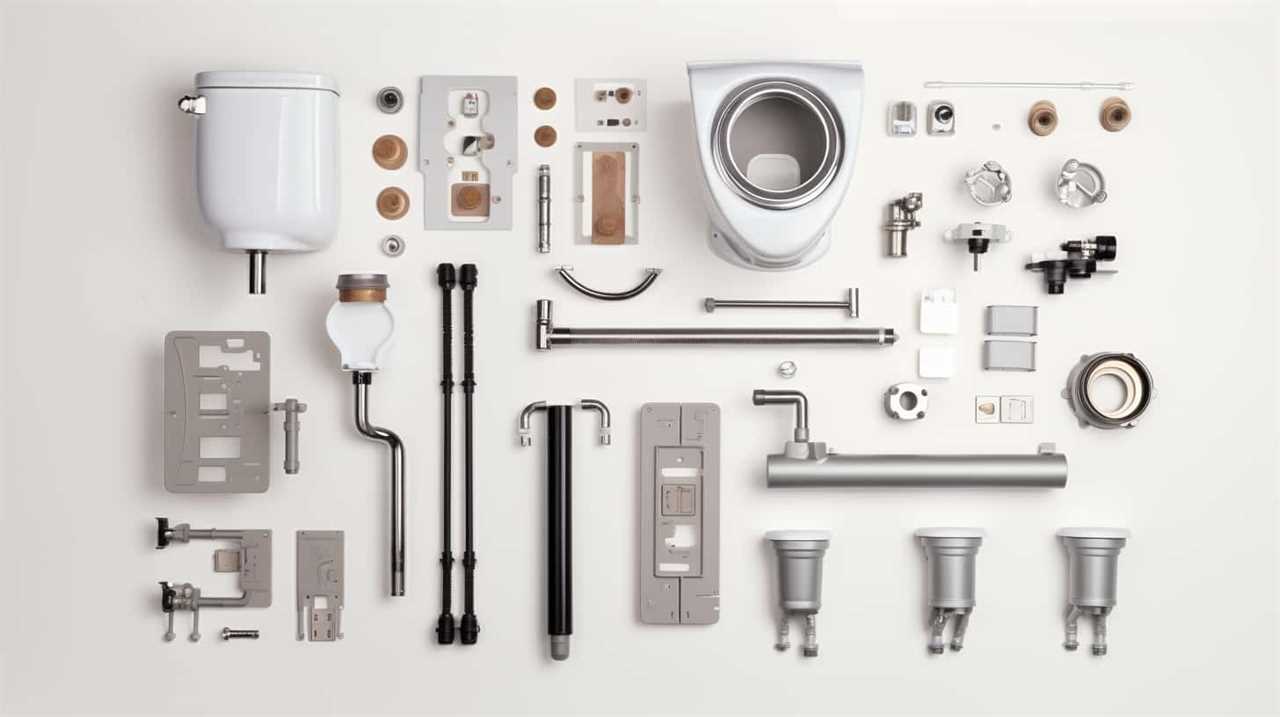
Frequently Asked Questions
Can a Toilet With a High GPF Be Converted to a Low GPF Toilet?
Yes, a toilet with a high GPF can be converted to a low GPF toilet. The conversion process involves replacing the flush mechanism. The benefits of low GPF toilets include water conservation and reduced water bills.
Are There Any Health Risks Associated With Using a Low GPF Toilet?
Using a low GPF toilet has health benefits and reduces the environmental impact. It helps conserve water and lowers the risk of waterborne diseases. Converting to a low GPF toilet is a wise choice.
How Can I Determine the GPF of My Current Toilet?
To determine the gpf of our current toilet, we can measure its water usage. This will help us understand how much water is being flushed with each use and determine if it meets the desired gpf rating.
Are There Any Government Incentives or Rebates for Installing Low GPF Toilets?
Yes, there are government incentives and rebates available for installing low GPF toilets. These programs aim to encourage water conservation and offer financial assistance to individuals who choose water-efficient options for their homes.
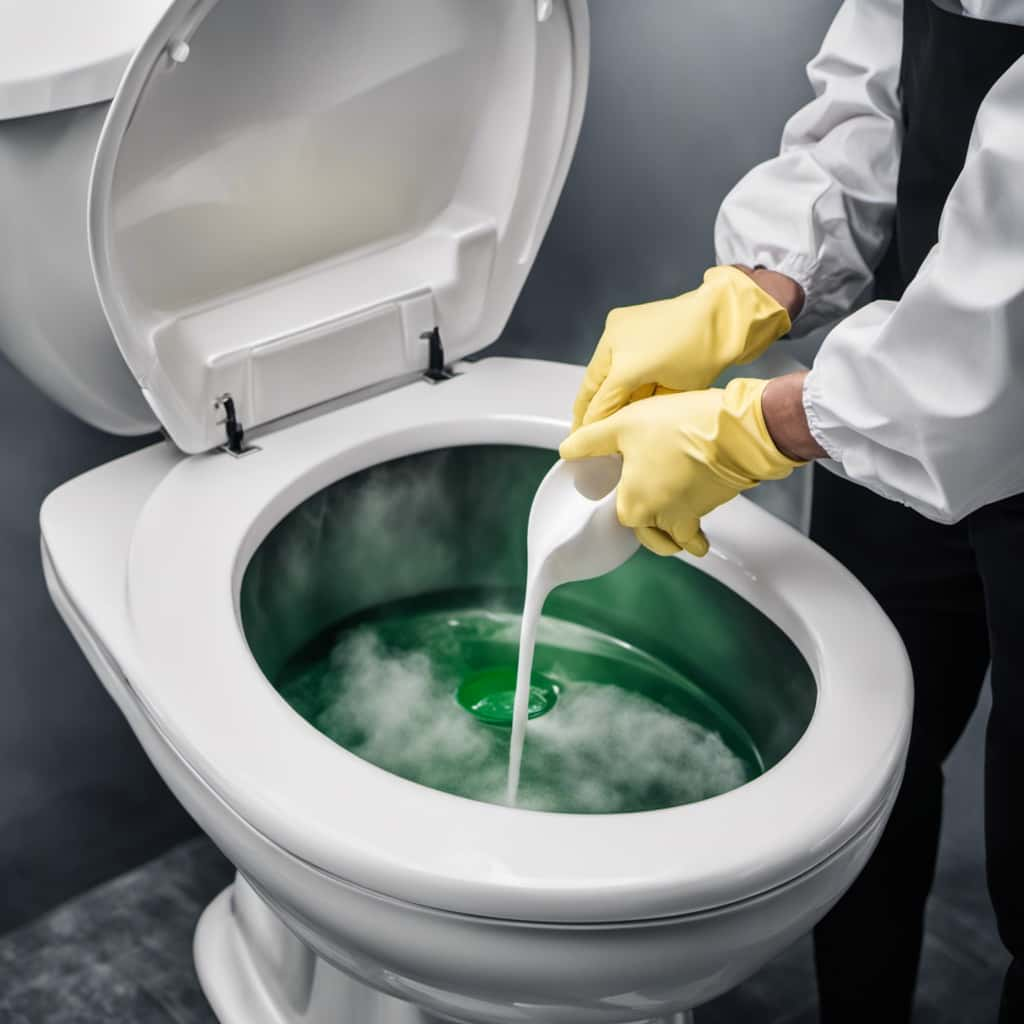
What Are Some Common Misconceptions About GPF and Its Impact on Water Conservation?
Common misconceptions about GPF and its impact on water conservation stem from a lack of understanding the relationship between GPF and toilet flushing efficiency. Proper education is crucial to dispel these myths.
Conclusion
In conclusion, understanding GPF is crucial when it comes to making informed toilet choices.
By knowing what GPF means and how it’s measured, we can make environmentally conscious decisions and reduce water usage.
Just like a river flowing freely, let’s ensure our toilets are efficient and sustainable, minimizing our impact on the environment.
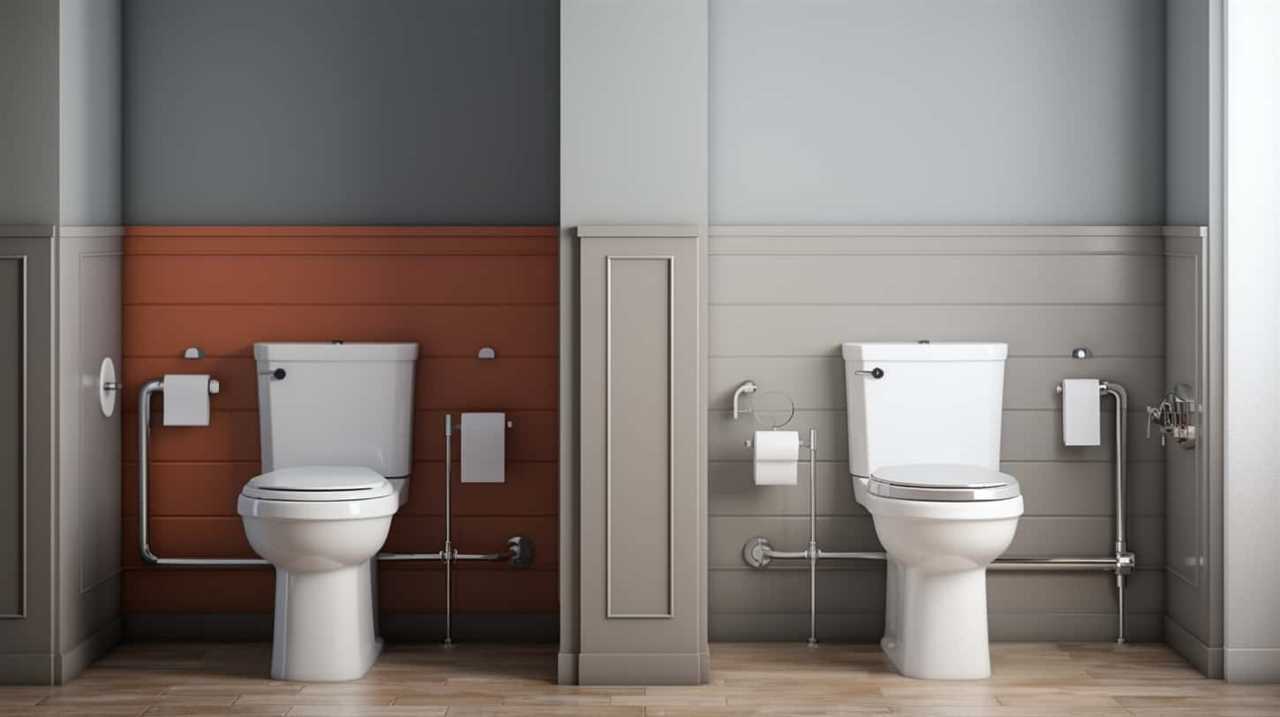
Together, we can make a difference, one flush at a time.



